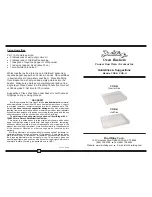
Fruit and Nuts Preparation
and Treatment
FRUIT
Nearly all fruits can be dried at home, but some
will require more drying time than others; the
guidelines offered here will help get you started.
It is recommended that you select the fruits that
are in season and experiment with those first.
Preparation
Wash and inspect fruits and remove any bruised
or overripe parts. Peel if desired. Cut larger fruits
in half. If the pieces vary too much in size, slice
them to 5-10mm thick for even drying. Smaller
fruits such as grapes and cherries may be dried
whole. Remove pits or stones from fruits such
as plums, cherries, apricots, etc. Always peel
fruits that have been artificially waxed. Peeling
is optional with other fruits – for instance, dried
pear skins tend to be grainy, and peach skin
peels are a little fuzzy.
Most fruits, like pineapples, grapes, strawberries,
and plums, can be placed directly on the drying
trays as they are prepared. However, some fruits
will turn brown when exposed to air (apples,
apricots, peaches, and pears). Following the
guidelines set below, you can pretreat these
fruits to slow this browning and to prevent loss
of vitamins A and C. To pretreat them, the cut
pieces should be kept in a holding solution until
you have sufficient fruit to dry.
Pretreatment
Below are several optional methods of
pretreatment. You don’t always need to pretreat
food in order to dry it; however, pretreatment can
make food look better, increase the shelf life and
even enhance the nutritional value. Experiment
with both treated and untreated food to see
which will work best. Remember, proper storage
is critical to the quality of the final product,
whether treated or untreated.
Sodium Bisulfite
Use food-safe (USP) grade only. Dissolve 1
teaspoon of sodium bisulfite in 1 litre of water.
Dip small amounts of fruit in the solution for 2
minutes. This helps prevent loss of vitamin C
and maintains a bright colour. Sodium bisulfite is
available in most pharmacies/drugstores.
Natural Pre-Dips
With their high vitamin C content, pineapple
and lemon juice are natural alternatives to other
pretreatments to reduce browning. Slice fruit
directly into juice. Remove after about 2 minutes
and place on trays. Fruits may also be dipped
in honey, lime or orange juice, gelatin powders
or sprinkled with coconut to give them an exotic
flavour. Use your imagination!
When drying fruit halves, especially apricots,
it has been suggested that popping the back
(“inside out”) will speed drying time. This is true,
but it also results in the loss of the nutritional
juices to the bottom of the dehydrator. Instead,
cut each half in half again to give the end product
more nutritional value, a brighter colour, and
faster reconstitution capabilities.
Apples
Wash thoroughly and peel if you wish.
Cut in half and core, then slice into
smaller pieces. Pretreat with lemon
juice to prevent browning.
Apricots
Wash, cut open and remove pit. If
desired, cut into quarters.
Bananas
Peel and slice. Pretreat with lemon
juice to prevent browning.
Cherries
Wash and remove pits.
Coconut
Drain the milk, open shell and remove
coconut meat. Dry and cut into small
chunks.
Figs
Wash, remove stems and cut into
halves or quarters. Place dry skin
side up.
Grapes
Remove stems and wash.
Papaya
Wash, peel and cut into chunks.
Peaches
Wash, slice in half and remove pit. If
desired, cut into quarters.
Pears
Wash, peel, slice in half to remove
core. Cut into chunks or slices.
Pretreat with lemon juice to prevent
browning.
Pineapple
Remove spiny skin, core and cut into
chunks or wedges.
Plums
Wash, cut in half and remove pit. If
desired, cut into quarters.
Strawberries Hull, wash and slice or leave whole,
as desired.
7


































